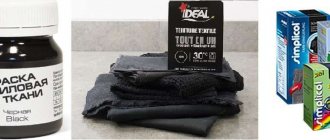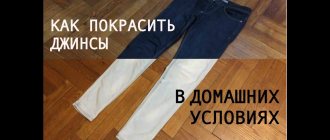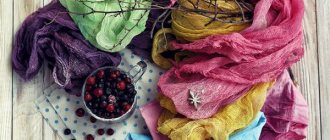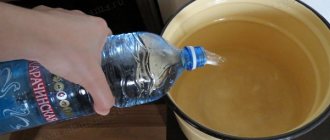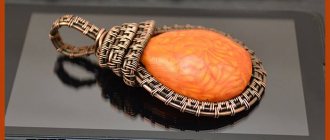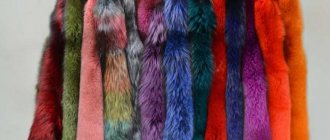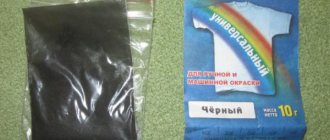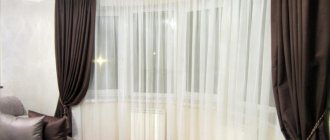Preparing for painting
Before you start working, you need to stock up on dyes and choose a method for doing the work.
Suitable materials
You can paint any item of clothing yourself using special paints .
There is a wide variety of colors available on the modern market. With such a spectrum, everyone can choose the shade they need.
Coloring methods
Fans of experiments identify several methods suitable for painting a product .
- The most popular is dyeing in a washing machine . However, paint may remain on the drum walls. This will lead to damage to other wardrobe items.
- Instead of a washing machine, you can use the manual method. For this purpose, enamel dishes are suitable, which are placed on low heat. The main thing when painting is to follow the manufacturer's recommendations .
How to paint it black
In the washing machine
In order to dye faded trousers black, you need to select the appropriate dyes. When the material has been selected, we begin the technological process.
For painting in a washing machine, it is recommended to use powder dyes .
- Pour the powder into a bowl and pour in about two glasses of hot water (per package) .
- Mix thoroughly to completely dissolve the paint.
- When the dye has dissolved, add a tablespoon of salt and mix again .
Note: It is recommended to use coarse salt.
- Now pour water into a large basin and add dye there .
- You also need to add one tablespoon each of vinegar and washing powder .
- Mix the resulting solution and pour it into the machine, then put the trousers in and wash with boiling water.
- After finishing, it is recommended to rinse the product additionally .
Important: the trousers must be damp before dyeing.
Painting by hand
To paint by hand, you need to purchase the appropriate paint.
- The paint is diluted with hot water and mixed until completely dissolved.
- After mixing, pour the paint into a large container (for example, a pan) and place the trousers.
- The pan is placed on low heat for about 40 minutes .
- During the cooking process, it is necessary to periodically stir the trousers . A special metal clamp or large spoon is suitable for this.
- While the trousers are going through the cooking process, you can prepare a rinse solution . Add 1 tablespoon each of vinegar and salt .
- When the dyeing time has expired, the trousers must be rinsed several times in a container with a solution, and then with regular running water.
The product is ready. Black trousers in front of you.
Help: salt and vinegar are used to accurately fix the color.
A few simple steps will help restore the brightness and saturation of the product.
How to dye a blouse or trousers at home
You can dye things at home if you familiarize yourself with the rules for using dyes. Nowadays, when the sphere of household services is completely absent, useful tips on how to paint things at home will always be useful to housewives. It often happens that a blouse or sweater, perhaps even trousers, are still good, but have lost their original color. Often you have to dye woolen sweaters knitted from old faded threads, or jeans that have lost their color; many people want to dye or redye children's clothes. The same can be said about furs, but fur can be dyed under special conditions. That’s when you have to show skill and do the dyeing yourself, at home. Where to start dyeing things?
First of all, you need to determine what material the fabric is made from..
Let's say the label on the item has already worn off, how can we determine in this case what fibers the fabric, blouse or trousers are made of? After all, the quality of coloring will depend on the correctly chosen dye. How to determine the type of fiber? To do this, pull out one thread at a time along and across the fabric and set it on fire with matches. Using combustion, you can determine almost the type of all the fibers from which a particular product or item of clothing is made. If the fabric is cotton, linen or viscose, the thread will burn quickly, evenly, with a bright flame, the smell will be of burnt paper and easily crumbling ash will remain. Acetate silk also burns quickly, but a glassy ball forms at the end of the thread, and when burning you can smell the acetic acid. If the threads on your product are nylon or nylon, then these materials do not burn, but simply melt, forming a soft ball. When ignited with a match, wool or natural silk burn poorly; a loose, sooty ball is formed at the end of the thread, which easily crumbles when touched; when burning, you can smell the smell of burnt bones.
Four types of dyes are used for dyeing at home: for cotton, linen and viscose fabrics; for wool; for natural silk; universal dyes for all types of fabrics and fibers, except acetate and synthetic fibers. Packets of dyes usually indicate how much weight a given amount of dye is designed for and what color the result will be . However, the color indicated on the dye packaging will turn out this way if the item being dyed is white; in all other cases, the color will turn out different. Natural silk can be dyed not only with dyes for silk, but also for cotton fabrics.
It is important to note that fabrics are often made from different types of fibers, and it can be difficult to determine exactly which ones they are made from, so before dyeing, you can check the effect of the dye on a small piece of fabric, and then dye the entire product.
Things must be dry and clean before painting. If you need to dye new cotton or linen fabrics or yarn, you need to boil them in a soap-soda solution for 30-40 minutes to remove starch. Wool yarn should be washed, this will remove excess fat from it. Items with stains that could not be removed can only be dyed in very dark colors. Before dyeing, you need to remove metal buttons and hooks; they can leave stains on things. Wool yarn in skeins must be tied in several places to prevent it from tangling.
If you are going to repaint things yourself at home, look at the data given in the table. This will help you choose the right dye to get the desired final color of the item being dyed. And then often the color after painting turns out to be gray-brown crimson. This happens especially often if you knitted a blouse from leftover threads, or children’s clothes from different threads, hoping that you would dye it later and everything would be the same color, but it doesn’t work out that way. What color will you get after dyeing?
| Color of the item being dyed | Dye color | The color you get |
| red | blue | Violet |
| yellow | Orange | |
| green | Brown | |
| blue | red | Violet |
| yellow | Green | |
| green | Blue-green | |
| brown | Dark brown | |
| yellow | red | Orange |
| blue | Green | |
| grey | Pea | |
| green | red | Brown |
| blue | Blue-green | |
| yellow | Yellow-green | |
| brown | Khaki | |
| grey | red | Dark red |
| blue | Dark blue | |
| yellow | Pea | |
| green | Gray-green | |
| brown | Dark brown |
If you have become familiar with the rules for dyeing things yourself at home, then you can proceed to the actual dyeing process.
Now we advise you to use little tricks when painting. To get the desired color, you can add other substances or dyes to the paint; let's see how to mix dye colors, for example:
If you take 1 part yellow dye and 1 part blue dye you get a salad color;
If you take 1 part red dye and 1 part blue you get a purple color;
If you take 1 part pink dye and 1 part blue dye you get a lilac color;
If you take 1 part yellow, ½ part red, ¼ part brown, 1/3 part black, you get a terracotta color;
If you take 100g of tea per 200g of wool and add a few grains of red dye, you will get a beige color, dye without salt and without vinegar;
To get the aqua color you need to take 1 part of blue dye and a few grains of green;
You cannot dye yarn with added salt in pink, blue, red, and light green colors;
In order for the green color to acquire a beautiful shade when dyeing wool yarn, you need to add a little yellow dye, diluting it separately and adding it to the solution.
Adding blue shades
There are also several methods for dyeing pants blue.
First of all, the use of ordinary blue - a mixture of methylene blue with starch. It is suitable for refreshing the product and giving it a more saturated color.
Manual method
- The dye is diluted in the amount of warm water indicated on the package, add a couple of tablespoons of table salt .
- Pants are placed in the resulting mixture. It is recommended to leave the product for several hours to obtain a bright and rich shade.
- Turn over about once every 2 hours to ensure even coloring.
- Before completing the process, you can prepare a solution with vinegar. Add 2 tablespoons of vinegar per liter of water . It is necessary to soak the painted product in the resulting solution for several minutes to consolidate the result. Then rinse several times.
Machine method
- When painting in a machine, powder dye is more suitable . It is diluted with boiling water and poured directly into the drum .
- Next come the trousers . It is recommended to set the mode to “Boiling”.
- While the product is going through the stages of dyeing, prepare a solution with vinegar . must be kept in it for at least 15 minutes.
- Afterwards rinse with water .
These steps will help restore your trousers’ rich color and well-groomed appearance.
How to dye your pants? We answer!
Are you planning to refresh and intensify the black shade of your favorite trousers that have faded or become pale? Or maybe you want to dye your white or light-colored pants pink, blue, dark green or yellow? Regardless of the desired effect - grey, brown, navy, black or colored - you have several options. Dyeing trousers - contrary to popular belief - is not a complicated process at all, as it seems at first glance. You can purchase a special dye for fabrics of any color or use homemade methods for dyeing pants.
Useful tips
For competent and complete coloring, you must follow several recommendations.
- For high-quality dyeing, it is recommended to use a dye suitable for the given fabric .
- When painting in a washing machine, the mixture must be poured into the drum, and not into the window for washing powder .
- To get a darker blue hue, you can add a little black paint..
- A solution of vinegar and salt is required when rinsing . It helps consolidate the result and prolong its quality.
- Before dyeing, trousers must be washed and all stains removed . When stained, they will reappear on the product.
How to choose paint
- Compound. Before purchasing, you need to pay attention to whether the ingredients of the product are listed on the label. In the production of counterfeit paints and compositions that are produced in artisanal conditions, important information is often missing, including the types of main components. In addition, the composition allows you to determine how high-quality and effective the chosen product is. Thus, it is recommended to purchase a helmet that does not contain lavsan and niton. These components can ruin the item because they contribute to its uneven coloring.
- Material type. The label indicates for which fabrics the composition is intended. If the wrong product is used, the material may be colored unevenly or may result in a color that is not what was expected, such as a lighter color. There is another danger: the material will be colored, but after the first wash it will begin to fade a lot.
- Type of paint. The compositions differ in structure, which determines their properties. The choice is made taking into account the method of application of the pigment. This is due to the fact that each type of paint is designed to paint products under given conditions. When the requirements for the procedure are not met, the quality of the painting deteriorates.
- Application of universal compositions. In the absence of information about the type of material, it is permissible to use a product that is suitable for dyeing cotton, linen, wool, silk, and viscose fabrics. In this case, the color can be preserved for a shorter period than in the case when a highly specialized composition is selected.
- Best before date. It is not recommended to use products that have lost their properties.
Clothes dye: a review of synthetic dyes
Paint selection:
- It is also worth paying attention to the amount of dye. If you want a light color on a white fabric, you need to add a small amount of dye. If you want a darker shade, add more than what is indicated in the instructions.
- Remember that it is advisable to keep dark things in the solution longer than light ones. If you are sorry to spoil the thing, it is best not to dye it. If there is a scrap, see how the fabric reacts to dyeing. Please note that wool, cotton, and silk items are prepared differently for dyeing.
- In order for the paint to adhere well, it is necessary to soak things in a solution of vinegar or baking soda with salt. This must be done before dyeing so that the paint adheres well to the fabric and does not wash off. After dyeing, you must thoroughly rinse the clothes in water until you get completely clear water without traces of dye.
- After the water becomes clear, you need to lightly wring out the clothes. Never dry painted items near heating sources or in direct sunlight. It is best to dry on a hanger. If it is wool, then drying it on a hanger can cause the product to stretch. Therefore, it is necessary to lay wool products on a sheet and dry them on a flat surface. After drying the clothes, re-sew the buttons and metal decor.
How to Dye Jeans
Review:
- Acrylic paint for fabric DEKOLA
- Fabric dye MARABU
- Fabric dye wholesale Aniline dye
- Fabric paint Textile Decola
- Fabric paint Textil
Fabric dyeing
Preparing for coloring
Considering that the process of updating trousers is accompanied by the appearance of paint splashes, you should choose a safe place in the apartment. It is better to perform similar actions in the bathroom, here you can clean the walls if necessary, since they are covered with moisture-resistant material from which dirt can be easily removed.
However, there is a risk of staining textiles: curtains, linen that is drying, etc. Such things must be removed from the room.
To avoid having to do general cleaning after finishing the procedure, you can additionally protect the surfaces with newspapers and polyethylene.
It is important to check the item for grease stains and traces of other complex contaminants. This can cause a deterioration in the quality of painting, since in these areas the pigment penetrates less intensively into the structure of the material coated with impermeable compounds (grease, paint, etc.). If possible, remove stains.
To ensure that the product looks like new after all manipulations, it is recommended to rip off the tags, stripes on the front side of the trousers, and also remove the emblems. If this is not done, all decorative elements will change color to a darker one.
You can pre-lighten the product. Then when dyeing it will be possible to get a more saturated color.
The following substances are used for this:
- oxygen or chlorine based bleaches;
- laundry soap;
- hydrogen peroxide;
- ammonia.
Dyeing clothes
To dye fabric, choose one of the techniques:
- Airbrush - painting using a spray can or airbrush.
- Shibori, tie-dye, plangi - knot painting. Before immersing the fabric in paint, it is pulled with threads, twisted, tied into knots and the folds are fixed with clothespins.
- Hot and cold batik. Patterns are created with hot wax or a special compound and the item is filled with dye. The areas where there was wax are the drawing, the painted areas are the background.
- Free painting.
- Boiling or soaking.
Preparation
Even new clothes need to be washed and ironed before painting. This will smooth out the fibers and allow the color to lie evenly. An exception is the tie-dye technique, in which the item, on the contrary, is crushed and twisted. The fittings and lining cannot be dyed together with the fabric. Pockets must be empty. When using any paint, read the instructions carefully so as not to damage the fabric.
Inventory
For partial staining you will need:
- brushes;
- cotton buds;
- a temporary pencil or self-disappearing sketch marker;
- stencil or copy paper;
- paper tape for a clear outline or fixation of the stencil;
- sponge if you need to shade the paint;
- wax, paraffin for batik;
- a hoop or sheet of thick cardboard to stretch the fabric;
- iron.
For full coloring:
- basin or pan;
- gauze or colander for straining broths;
- gloves, tweezers or wooden sticks for turning the fabric.
General recommendations
There are certain recommendations for coloring:
- Paint each item separately.
- When you soak, periodically remove and dip again to properly paint the texture.
- The dye penetrates deeper into the fibers of the fabric in hot water, but after dyeing it is not recommended to wash things at high temperatures.
- In decoctions of leaves and berries, the fabric can be boiled for about 40 minutes.
- The seams are not painted over.
- Faded fabric easily absorbs dye.
- Stains interfere with dyeing - contaminated areas will differ in color.
- Natural dyes take longer to dye the fabric, and the color is unstable.
- After painting, the item should be rinsed well until the water becomes clear.
- When drying, woolen items are carefully laid out, otherwise they will stretch.
- Do not leave things in the sun for a long time so that the color does not fade again.
- Wash dyed items separately from the rest for a while.
Types of dyes
Industrial production means:
- powder compositions: paint is available in dry form, in powder form;
- Ready-to-use liquid products are specially developed pigments intended for dyeing fabrics.
Use available tools:
- refilling printer cartridges (black);
- natural coffe;
- tobacco ash.
These options are not recommended for improving the color of expensive items, since there is a high probability that the trousers will be irreparably damaged. There is no guarantee of a good result in this case.
How to paint it black
At the selection stage, the appropriate type of pigment is determined. First put on rubber gloves. If this is not done, the skin on your hands will darken.
In the washing machine
In this case, powder dye is used. It must be properly prepared. So, use a glass container; a metal spoon is needed to mix the solution. Powder paint is mixed with hot water in the ratio of 1 package of powder to 2 cups of liquid. When the mixture has become uniform, add 1 tbsp. l. salt. The composition must be mixed again until a homogeneous substance is obtained.
The finished dye is mixed with water. The amount of liquid is determined by the manufacturer; such information can be found on the label. Add 1 tbsp to the prepared solution. l. vinegar and the same amount of washing powder. At the last stage, the dye is poured into the machine. The trousers are placed in a drum. High temperature mode (+90°C) is recommended. At the end of the cycle, the product is rinsed.
Painting by hand
The pigment is combined with water, and the liquid must be hot. The paint is poured into the container. It is more convenient to mix the components in a basin: immerse the trousers in the prepared solution and place the container on the stove. The fire should be low and should not be brought to a strong boil. Warm-up duration is 40 minutes. The product that is being painted must be stirred periodically, for which a metal object, such as a spoon, is used.
Prepare the rinse liquid: fill a basin with water, add 1 tbsp. l. vinegar and the same amount of salt. The solution helps set the color. When the heating period for the product is over, the trousers need to be rinsed several times in the prepared product, and then in running water.
Dyeing jeans blue
For this purpose, a classic version of the dye used in domestic conditions is often used - blue. You can also take industrial products for highly specialized purposes - for dyeing fabric blue.
Machine method
The technology in this case is the same as when using black pigment. However, it is recommended to rinse the product in a solution of water and vinegar.
First, jeans are soaked in this product for 15 minutes, after which they proceed to rinsing in running water. The manipulations are repeated until the pigment stops flowing from the fabric.
Manual method
Dilute the dye with water in accordance with the manufacturer's recommendations. Add 2 tbsp to the resulting solution. l. salt. In order for the dye to do its job better, it is recommended to soak your trousers in it for several hours. The color will be uniform if you turn the product over every 2 hours.
For rinsing, prepare another solution: 1 liter of water and 2 tbsp. l. vinegar, the amount of components changes proportionally. It is necessary to soak the jeans in this product for 15 minutes, after which the product is rinsed in running water.
They do a lot of things to jeans to give them a fashionable look - tinder, boil them, tear them, decorate them with rhinestones and appliqués. “Distressed” denim has been popular for a long time. But lovers of conservative plain trousers, on the contrary, prefer to dye their jeans if they have begun to fray and lose their color uniformity.
If you decide to dye your jeans, you don’t have to take them to the dry cleaner - you can restore the color of the fabric yourself at home. Both special dyes and a variety of improvised means are suitable for coloring.
It is easier to achieve high-quality uniform dyeing of fabric when the selected paint matches the original color or is darker than it. That is, any jeans can be easily dyed black, but turning black trousers, for example, into blue is unlikely.
Fabric dyeing: subtleties of color choice and fabric features
It is worth first deciding on the type of fabric. You need to understand that fabrics made of silk, wool, cotton, and linen are dyed well. Products made of polyester or synthetics are dyed quite poorly, so we do not recommend that you dye such fabrics at home. Excellent dyeing of denim. For this you can use both natural and artificial dyes.
Color selection:
- Artificial dyes can be purchased at a household chemical store. Choose a dye depending on the color of the fabric, as well as your desire for the color you want. The most interesting thing is that it is best to paint colored products in dark colors.
- Black would be the ideal option. It can cover any color shades. White fabric dyes best and can be dyed any color. In this case, the shades can be quite bright or dark. Choose dyes that are a little darker than you want if you are dyeing white fabric. If you are dyeing colored fabric, choose, on the contrary, a lighter dye than you want to get in the end.
- Remember that dyeing red fabric green is unlikely to work, because the original color will overwhelm the new shade. The end result will be a dirty color with a strange tint. It is for this reason that colored items are dyed dark blue, dark brown or black.
Fabric dyeing
How to dye blue jeans
Let's move straight to the description of the means with which you can restore the rich blue color of your jeans.
Traditional denim dye used to be made from the Indian indigo plant, from which it gets its name. Its color is characterized as intermediate between dark blue and violet. To dye jeans at home and provide them with an even and lasting blue color, use ready-made textile paints and available products.
Blue
Blue in the form of a solution or powder is one of the most affordable and easy-to-use dyes.
Dyeing jeans blue is quite simple - you don't even have to boil them. It is enough to make a saturated concentrated solution using cool water (about 30 ℃) with the addition of 1-2 tbsp. l. salt for color fastness, and immerse things in it. It is recommended to soak jeans for 1.5-2 hours or even the whole night, and it is important to ensure that the fabric is completely immersed in water. After soaking, the jeans are placed in a cold vinegar solution for 10-15 minutes.
Drying painted items is necessary in a straightened form; it is best to lay them out on a horizontal surface. Otherwise, water flowing down the folds will wash away the color, making it uneven.
A serious disadvantage of blue dyeing is that the color fades quite quickly with subsequent washes, and the procedure will need to be repeated regularly.
Dylon
Dylon is one of the new household chemicals designed for both washing and tinting denim. The product is convenient, economical and quickly gaining popularity among fans of classic denim.
Aniline dyes for fabric
The use of aniline dyes for blue jeans has some peculiarities.
When using aniline dyes, table salt must be added for color fastness. Details of the technology and the required proportions must be indicated by the manufacturer on the packaging. Typically, a bag of powder paint is designed for 7-10 liters of water. It is first diluted in a small volume, achieving complete dissolution, and then poured into the full volume of water. Add salt (100 g) there and mix thoroughly. Things to be dyed are immersed in a container in a straightened form and make sure that they are completely covered with the solution.
Ready-made paints in liquid forms wash out faster and are more suitable for refreshing the base tone. To properly dye jeans or completely change their original color, it is advisable to choose paints in the form of powder formulations.
Don't be afraid to experiment and give new life to your favorite things!
How and with what to dye black jeans
In cases with black jeans, we can only talk about color restoration, so black dyes are needed.
Dyeing black jeans involves restoring and evening out the color
Fabric paint
How to dye black jeans at home? If you don’t like experiments and surprises, buy special fabric dyes .
In ancient times, textile dyes were made from natural materials (minerals and plants), but now most dyes are based on chemicals
Before you dye your jeans black, make sure they are clean and free of stains. Any greasy or dirty stains change the structure of the fibers, and the paint in such places will lie unevenly. Accordingly, the stains must first be removed, and then the trousers must be washed without using conditioner (it may interfere with further staining). Before you dye your jeans, you need to dry them, turn all the pockets and the pants themselves inside out.
Helpful tip: If you're cutting denim to shorten it to your desired length, don't throw away the leftover material. These pieces can be used in the future to test the effect of solvents and dyes if it is necessary to remove stains or dye jeans.
The next stage of preparation is to read the instructions for using the dye and choose a convenient dyeing method. You can dye jeans either manually or using an automatic washing machine. Let's consider each of the methods in detail.
Dyeing in the washing machine
First of all, prepare the paint as indicated in the instructions. Remember that it is better not to pour dry powder into the machine, but to first dilute the dyes (powder and even liquid) in a small amount of hot water to avoid the formation of lumps and clots. The presence of dense fragments will lead to stains on the fabric. If you want to achieve an even and lasting color, strain the paint solution through cheesecloth several times until you obtain a homogeneous mass.
The diluted dye is poured directly into the drum of the washing machine.
Pour the prepared dye into the drum of the washing machine and add (if the instructions require it) salt, soda or a color fixer, which is sometimes included with the dye itself.
Place your jeans inside out and well-stretched in the machine. Typically, denim clothing labels indicate a recommended washing temperature of up to 40℃, but this may not be sufficient for dyeing. A better result will be obtained if you choose a mode with a temperature of 90-95 ℃ and a cycle duration of 1.5-2 hours.
Powder and conditioner should not be added to the washing machine when dyeing jeans - the products can ruin the result.
While the jeans are in the machine, prepare a rinsing solution: add 1-2 tbsp to 1 liter of warm water. l. 9% vinegar.
Baking soda and salt are sometimes added to fix the color when dyeing, but 9% table vinegar is rightfully considered the most effective remedy.
After the machine has finished working, the painted items are taken out of the drum and immersed in a vinegar solution for 10-15 minutes. Then the jeans are washed again using the normal cycle (up to 40 ℃) and detergents for colored fabrics. Repeating the cycle will help remove any remaining dye from the fabric and from the machine itself. All that remains is to dry the updated jeans, and also wipe the seals and rubber gaskets of the washing machine with a damp sponge.
Dyeing in the washing machine will not harm the appliance itself, but a small amount of colored water may remain in the drum, which can harm your clothes. To protect yourself from unplanned coloring of light-colored clothes and linen during subsequent washes, run the machine again in idle mode. By the way, it’s a good idea to add citric acid at the same time - at the same time, clean your unit from scale.
Hand dyeing
It's easy to dye jeans by hand.
To dye clothes evenly, you will need a large container that can be placed on the fire and in which you can spread things out as much as possible.
The preliminary steps will be the same as for machine dyeing: the jeans are inspected and, if necessary, washed, and then dried and turned inside out. The paint is diluted and filtered to remove lumps.
In order to dye jeans, it is best to take a large enamel bowl with a volume of 6-10 liters, fill it 2/3 with water and put it on fire. After the water is heated, all the necessary ingredients (paint, soda, salt) are added to it. The solution is mixed well, and the prepared items are immersed in it so that they are completely covered with water. To prevent jeans from floating, they must be periodically submerged under water and turned over using available means. The dyeing process in hot (but not boiling!) water will take 40-60 minutes. In this case, it is advisable to cover the container with a lid so that less chemicals evaporate into the air, and ventilation should be provided in the room.
After boiling, the jeans should be rinsed first in warm water and then in cold running water. To fix the color, they are also soaked for 10-15 minutes in a weak solution of 9% vinegar (1-2 tbsp per 1 liter of water).
After soaking in a vinegar solution, the jeans are washed using regular soaps.
The big advantage of hand dyeing is that you can control the entire process and be creative. Various options for twisting, pinching, and creasing the fabric can give a unique result in the form of unusual patterns or ornaments, color spots and stains, or the popular “varenka” effect on jeans.
Alternative Dyes for Black Jeans
If for some reason you are not satisfied with ready-made textile dyes, there are other options. True, they are all very controversial and more expensive.
Hair dye
In order to dye jeans black, you will need black hair dye, preferably without ammonia and with natural pigments.
The paint must be chosen in a pure black color - without additional tints or shades
To dye one pair of jeans, you will need two packages of hair dye. The dye is diluted in a small volume of water (it should be enough to completely immerse the fabric) without oxidizing agents or other additives. Mix the water and dye well to make the solution homogeneous, place the jeans in it and leave for 1-1.5 hours. To achieve uniform dyeing, the fabric needs to be pressed and turned from time to time.
When working with dye, be sure to wear gloves.
After soaking in the dye mixture, the items should be rinsed and immersed in the vinegar solution for another 15-20 minutes. To better fix the color, it is recommended to add table salt to the vinegar at the rate of 1 tbsp. l. for 1 liter of water. It is important to understand that such dyeing will not be permanent, and the jeans will fade with each subsequent wash.
Ink from felt-tip pens
To paint jeans, it is recommended to take several black felt-tip pens, take them apart, and dip the ink rods into cool water. When the water turns black, jeans are immersed in it and kept for at least 1 hour.
Aerosol and acrylic paints
They are used not exactly for coloring, but rather for decorating your favorite things.
Using acrylic or aerosol paints, you can paint any patterns and ornaments on fabric.
Aerosol paints are simply sprayed over the surface of laid out jeans, while acrylic paints are applied using brushes or the edge of a sponge. At the same time, it is almost impossible to achieve uniform coloring, but you can safely create, showing all your imagination. Interesting results can be obtained if you use stencils. After painting, acrylic is fixed to the fabric, ironed with a hot iron, laying layers of white paper on top and bottom of the jeans.
